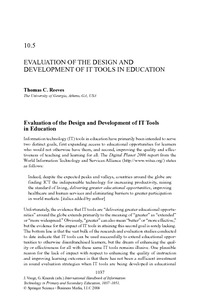Evaluation of the Design and Development of IT Tools in EducationZu finden in: International Handbook of Information Technology in Primary and Secondary Education (Seite 1037 bis 1051), 2009
|
 |
 Diese Seite wurde seit 1 Jahr inhaltlich nicht mehr aktualisiert.
Unter Umständen ist sie nicht mehr aktuell.
Diese Seite wurde seit 1 Jahr inhaltlich nicht mehr aktualisiert.
Unter Umständen ist sie nicht mehr aktuell.
 Zusammenfassungen
Zusammenfassungen
 Information technology (IT) tools in education have primarily been intended to serve two distinct goals, first expanding access to educational opportunities for learners who would not otherwise have them, and second, improving the quality and effectiveness of teaching and learning for all. The Digital Planet 2006 report from the World Information Technology and Services Alliance (http://www.witsa.org/) states as follows: Indeed, despite the expected peaks and valleys, countries around the globe are finding ICT the indispensable technology for increasing productivity, raising the standard of living, delivering greater educational opportunities, improving healthcare and human services and eliminating barriers to greater participation in world markets. [italics added by author]
Information technology (IT) tools in education have primarily been intended to serve two distinct goals, first expanding access to educational opportunities for learners who would not otherwise have them, and second, improving the quality and effectiveness of teaching and learning for all. The Digital Planet 2006 report from the World Information Technology and Services Alliance (http://www.witsa.org/) states as follows: Indeed, despite the expected peaks and valleys, countries around the globe are finding ICT the indispensable technology for increasing productivity, raising the standard of living, delivering greater educational opportunities, improving healthcare and human services and eliminating barriers to greater participation in world markets. [italics added by author]Unfortunately, the evidence that IT tools are 'delivering greater educational opportunities†around the globe extends primarily to the meaning of 'greater†as 'extended†or 'more widespread.†Obviously, 'greater†can also mean 'better†or 'more effective,†but the evidence for the impact of IT tools in attaining this second goal is sorely lacking. The bottom line is that the vast bulk of the research and evaluation studies conducted to date indicate that IT tools can be used successfully to extend educational opportunities to otherwise disenfranchised learners, but the dream of enhancing the quality or effectiveness for all with these same IT tools remains illusive. One plausible reason for the lack of impact with respect to enhancing the quality of instruction and improving learning outcomes is that there has not been a sufficient investment in sound evaluation strategies when IT tools are being developed in educational contexts. The purpose of this chapter is to describe the state of the art of evaluation strategies for IT tools in education, with a special focus on mixed methods used in service of the design and development of educational software.
 Dieses Kapitel erwähnt ...
Dieses Kapitel erwähnt ...
 Personen KB IB clear | Jakob Nielsen | ||||||||||||||||||
 Bücher |
|
 Zitationsgraph
Zitationsgraph
 Zitationsgraph (Beta-Test mit vis.js)
Zitationsgraph (Beta-Test mit vis.js)
 3 Erwähnungen
3 Erwähnungen 
- Second Handbook of Information Technology in Primary and Secondary Education (Joke Voogt, Gerald Knezek, Rhonda Christensen, Kwok-Wing Lai) (2018)


- 77. Researching Information Technology in Education: Meeting the Challenges of an Ever-Changing Environment (Margaret J. Cox)


- 79. Researching the Design and Evaluation of Information Technology Tools for Education (Eric Bruillard, Georges-Louis Baron)


- 81. Measuring the Impact of Emerging Technologies in Education - A Pragmatic Approach (Mutlu Cukurova, Rose Luckin)


- 77. Researching Information Technology in Education: Meeting the Challenges of an Ever-Changing Environment (Margaret J. Cox)
 Anderswo finden
Anderswo finden
 Volltext dieses Dokuments
Volltext dieses Dokuments
 |  Evaluation of the Design and Development of IT Tools in Education: Artikel als Volltext bei Springerlink ( Evaluation of the Design and Development of IT Tools in Education: Artikel als Volltext bei Springerlink ( : :  , 157 kByte; , 157 kByte;  : :  2020-11-28) 2020-11-28) |
 Anderswo suchen
Anderswo suchen 
 Beat und dieses Kapitel
Beat und dieses Kapitel
Beat hat Dieses Kapitel während seiner Zeit am Institut für Medien und Schule (IMS) ins Biblionetz aufgenommen. Beat besitzt kein physisches, aber ein digitales Exemplar. Eine digitale Version ist auf dem Internet verfügbar (s.o.). Aufgrund der wenigen Einträge im Biblionetz scheint er es nicht wirklich gelesen zu haben. Es gibt bisher auch nur wenige Objekte im Biblionetz, die dieses Werk zitieren.











 Biblionetz-History
Biblionetz-History